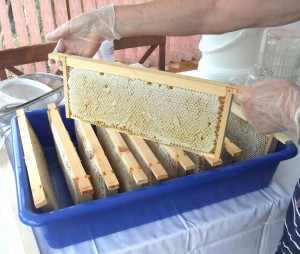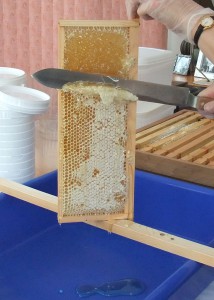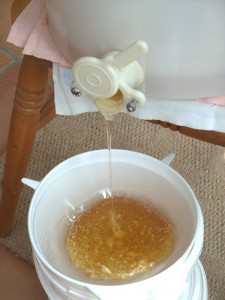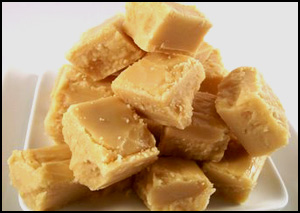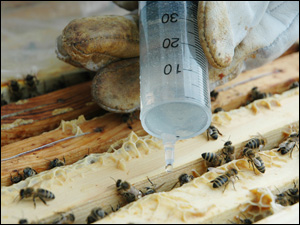In the Apiary in May. Nigel Salmon.
1 Regular check for queen cells/swarm control/clipped queens
2 Check for brood disease, esp. EFB
3 Add supers ahead of requirement
4 Clear/extract/replace supers after oilseed rape flow
5 Monitor varroa situation
We are having another wonderful spring again, and the bees are building up quickly, foraging on cherries, plum and increasingly oilseed rape. One of my 2 hives occupies a brood and 4 supers at present (first cross Buckfast) so they will need frequent checking for queen cells – the other hive is about where I would expect them to be for the time of year..
This month, you should be checking your hives at weekly (if you have an unclipped queen) or 10 day intervals (if she is clipped) to spot the first signs that the bees are preparing to swarm (bees will not normally swarm until they have drones on the wing, so you probably don’t need to check hives that haven’t produced any yet). Remember, it only takes 8 days from the queen laying in a queen-cell to the time it is sealed, and on that day, or the first fine sunny day thereafter if it happens to be dull and wet, the old queen will usually leave the hive with between a third and a half of the workers. They will cluster for a while (anything from a few hours to one or two days) quite close to the hive whilst scout bees search for a suitable new home, and if not captured by the beekeeper, will leave for an unknown destination. This is the scenario if the queen’s wings have not been clipped. If, however, the queen’s wings have been clipped, then when the swarm emerges, either the queen will drop onto the grass and be lost, in which case the swarm will return and await the first virgin to emerge before they can swarm, or the bees will find the queen and cluster around her very close to the hive. You can see by this that clipping a queen’s wings might buy you up to 5 or 6 extra days before the bees can swarm again, but you need to be vigilant. Also, do keep well ahead of the bees when supering so that you do not force them to swarm in the first place.
On finding occupied queen cells, you need to make an artificial swarm (see April’s notes) unless you can visit your apiary daily and so pick up any swarms that emerge. For ease of manipulation, allowing the bees to swarm, collecting them in a container and hiving them in the evening cannot be bettered, but it isn’t always possible or desirable if neighbours might get involved or the bees are in a distant, infrequently visited out-apiary.
If you have an aggressive hive that you dread inspecting, a simple method of re-queening it without finding the queen is to cut out a good queen cell from one of your more amenable hives that is preparing to swarm, place this carefully in a queen cell protector (available from the bee equipment manufacturers), then make an indentation in a brood frame in the aggressive hive and press the queen cell in its protector into the gap you created. You will need to have gone through this stock and removed any of its own queen cells first. Close the hive and don’t go near the broodnest for a month, after which you can check and see if you have a new queen – in a surprising number of cases a virgin queen will emerge and kill your resident queen and after mating should settle down to lay, although nothing is 100% certain with bees. Moving the hive across the apiary so that it loses most of its flying bees will ensure it doesn’t swarm and I am sure other beekeepers can think of more variations on this theme.
Fields of oilseed rape will have been in flower for 3 weeks or more, and supers should have been added well in advance of them being needed. From the middle of this month, you will hopefully have full supers to extract – so long as the combs are at least 2/3 sealed, and no drops fly out if you gently shake the frame horizontally over the hive, then it should be ok to clear the bees and remove the super/s. Clearing bees can be achieved using porter escapes or one of the more rapid methods based on the canadian clearer boards; I have had a lot of success using a Thorne’s fume board impregnated with ‘Bee Quick’, but it does need warm weather to be totally effective; if the sun isn’t shining then the board can be warmed using a blow torch. I have also read that you can impregnate a cloth with Bee Quick and put the cloth into a smoker (unlit of course) – by operating the bellows you will vapourise the solution and clear the bees from the super. Whichever method you use, you should aim to remove and extract the supers as quickly as possible if the bees have been foraging on oilseed rape– if the supers being cleared are left unoccupied for long, and especially if the nights are cold, then the honey can become very viscous and difficult to extract. After a week, you will probably find them well on the way to becoming totally granulated.
Whilst you are inspecting your hives, do carry out a disease check of the brood, especially looking at three or four frames containing larvae after shaking off most of the bees, to check for European foul brood, for at this time of the year it is much easier to spot.
Lastly, don’t forget to keep monitoring the varroa levels in your hives, and if the counts indicate that the mite population in your hives is reaching a critical level, then you need to do something to lower the population. Making a shook swarm in a fresh broodbox and then treating the displaced bees and brood in the original broodbox with Apiguard will control the mite population. Using mesh floors on all your colonies may keep mite numbers at a reduced level, but you must clean the collecting tray at least weekly if problems with wax moth are to be avoided or perhaps leave the collecting tray out altogether.

